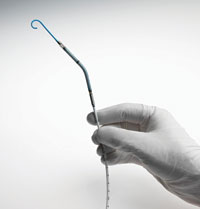
Posted to News on 23rd Nov 2014, 00:00
Pumps support the heart by keeping blood flowing
Whether in an acute emergency or during a planned operation, instability in the movement of blood around the body is a feared and serious complication which can occur when occluded coronary arteries are opened.

>Abiomed Europe saw an opportunity for a new design of miniature blood pump - the Impella - which would mimic the natural cardiovascular system which transports oxygenated blood from the left ventricle through the aortic valve and into the ascending aorta, from where the blood enters the coronary vessels and the systemic circulation. But this would require an extremely small drive.
>With an available diameter of just a few millimetres to play with in the Impella design, Abiomed turned to Faulhaber for a suitable drive. The solution was a pump drive consisting of a brushless, electronically commutated DC motor with a diameter of just 4mm in the case of the smallest pump (the Impella 2.5) and 6.4mm in the case of the larger pump (Impella 5.0) and a stator length of 12 and 18mm respectively.
>Using a guide wire inserted via the femoral artery, the Impella pump is positioned in the left ventricle and ascending aorta. The pumping performance of the heart is supported with a speed of up to 51,000 revolutions per minute.
>The drive is based on a self-contained coil and essentially consists of a three-phase winding and a bipolar permanent magnet. The position of the rotor is detected by measuring and evaluating the retroactive generator voltage, making Hall sensors unnecessary. The Impella pump is controlled using an external console which is also used to optimise settings and to monitor the effect of the pump.
>An impressive feature of the motors, available in the UK from EMS, is their high level of efficiency. The pressure sensors on the larger pump, which are required in the case of positioning inside the ventricles, have a thickness of 300_m and are positioned in a flat area on the outside of the motor housing. Apart from the compact dimensions and the high reliability, the comparatively favourable cost/performance ratio is another important factor because each Impella pump can be used only once.
>Today the pumps have already been used over 160,000 times worldwide. Able to deliver up to five litres of blood per minute, the pump actively relieves the strain on the left ventricle, supporting the heart for up to ten days and so giving it time to recover.
>Throughout the design, Abiomed worked closely with Faulhaber. The demands placed on a medical product used in life-critical situations are very high, but Abiomed found Faulhaber to be a reliable partner right from the beginning, developing components exactly as needed. Continuous development of the Impella means that the preparation time required before the pump can be put into action has been reduced to under three minutes. This means patients can be treated without delay, even in acute emergencies.
EMS (Electro Mechanical Systems)
Eros House
Calleva Industrial Park
RG7 8LN
UNITED KINGDOM
+44 (0)118 9817 391







